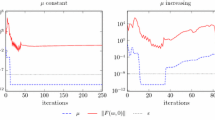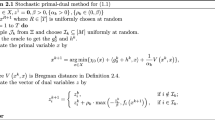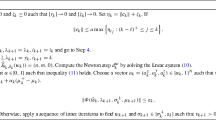Abstract
In this paper we describe a Newton-type algorithm model for solving smooth constrained optimization problems with nonlinear objective function, general linear constraints and bounded variables. The algorithm model is based on the definition of a continuously differentiate exact merit function that follows an exact penalty approach for the box constraints and an exact augmented Lagrangian approach for the general linear constraints. Under very mild assumptions and without requiring the strict complementarity assumption, the algorithm model produces a sequence of pairs {.r k. λk converging quadratically to a pair (x, λ) where x satisfies the first order necessary conditions and λ is a KKT multipliers vector associated to the linear constraints. As regards the behaviour of the sequence {r K alone, it is guaranteed that it converges at least superlinearly. At each iteration. the algorithm requires only the solution of a linear system that can be performed by means of conjugate gradient methods. Numerical experiments and comparison are reported.
This work was partially supported by MURST National Research Program “Metodi per l’ Ottimizzaione di Sistemi e Tecnologie (MOST)”.
Access this chapter
Tax calculation will be finalised at checkout
Purchases are for personal use only
Preview
Unable to display preview. Download preview PDF.
Similar content being viewed by others
References
J. F. Bonnans and C. Pola, “A trust region interior point algorithm for linearly constrained optimization,” SIAM J. on Optimization, vol. 7, pp. 717–731, 1997.
A. Ciancimino, G. Inzerillo, S. Lucidi and L. Palagi, “A mathematical programming approach for the solution of the railway yield management problem,” Transportation Science (to appear).
F.H. Clarke, Optimization and Nonsmooth Analysis, John Wiley & Sons: New York, 1983.
A. Conn, N. Gould and P. Toint, Lancelot. A Fortan Package for Large-Scale Nonlinear Optimization (Release A), Springer-Verlag: Berlin, 1991.
A. R. Conn, N. Gould and Ph. L. Toint, “A primal-dual algorithm for minimizing a nonconvex function subject to bound and linear equality constraints,” Technical Report 96/9, Dept. of Mathematics, FUNDP, Namur(B), 1996.
A. R. Conn, N. Gould and Ph. L. Toint, “A globally convergent Lagrangian barrier algorithm for optimization with general inequality constraints and simple bounds,” Technical Report 92/7(2nd revision), 1995.
R. S. Dembo and T. Steihaug, “Truncated Newton algorithms for large scale unconstrained optimization,” Mathematical Programming, vol.26, pp. 190–212, 1983.
G. Di Pillo, S. Lucidi and L. Palagi, “A superlinearly convergent algorithm for constrained nonlinear pro gramming problems with bounded variables,” Technical Report DIS 02.99, 1999.
G. Di Pillo, “Exact penalty methods,” in Algorithms for Continuous Optimization: the State of the Art, pages 1–45. Kluwer Ac. Press, Boston, (1994).
G. Di Pillo and L. Grippo, “An augmented Lagrangian for inequality constraints in nonlinear programming problems,” Journal of Optimization Theory and Applications, vol. 36, pp. 495–519, 1982.
G. Di Pillo and L. Grippo, “Exact penalty functions in constrained optimization,” SIAM Journal on Control and Optimization, vol. 27, pp. 1333–1360, 1989.
G. Di Pillo, L. Grippo and S. Lucidi, “Globally convergent exact penalty algorithms for constrained optimization,” Technical Report CNR-IASI no. 128, 1985.
G. Di Pillo and S. Lucidi, “On exact augmented Lagrangian functions in nonlinear programming,” in Nonlinear optimization and applications: Proceedings of the International School of Mathematics, Erice, Italy, 1995.
G. Di Pillo and S. Lucidi, “An augmented Lagrangian function with improved exactness properties,” Technical Report DIS 18.95, 1995.
G. Di Pillo, S. Lucidi and L. Palagi, “An exact penalty-Lagrangian approach for a class of constrained optimization problems with bounded variables,” Optimization, vol. 28, pp. 129–148, 1993.
F. Facchinei and S. Lucidi, “A class of methods for optimization problems with simple bounds,” Technical Report CNR-IASI no. 336, 1992.
F. Facchinei and S. Lucidi, “Quadratically and superlinearly convergent algorithms for the solution of inequality constrained minimization problem,” J. of Optimization Theory and Application, vol. 85, pp. 265–289, 1995.
F. Facchinei, “Minimization of SC1 functions and the Maratos effect,” Operations Research Letters, vol. 17, pp. 131–137, 1995.
A. Forsgren and W. Murray, “Newton methods for large-scale linear inequality-constrained minimization,” SIAM J. on Optimization, vol. 7, pp. 162–176, 1997.
A. Forsgren and W. Murray, “Newton methods for large-scale linear equality-constrained minimization,” SIAM J. Matrix Anal. and Appl., vol. 14, pp. 560–587, 1993.
P. E. Gill, W. Murray and M. A. Saunders. “SNOPT: An SQP Algorithm for large-scale constrained optimization,” Technical Report NA 97-2. Dept. of Mathematics, University of California, San Diego, 1997.
L. Grippo, F. Lampariello and S. Lucidi, “A truncated Newton Method with nonmonotone line search for unconstrained optimization.” J. of Optimization Theory and Application, vol. 60, 1989.
L. Grippo, F. Lampariello and S. Lucidi. “A class of nonmonotone stabilization methods in unconstrained optimization,” Numer. Math., vol. 59. pp. 779–805, 1991.
J.B. Hiriart-Urruty, J.J. Strodiot and V.H. Nguyen, “Generalized Hessian matrix and second-order optimality conditions for problems with C1.1 data,” Applied Mathematics and Optimization, vol. 11, pp. 43–56, 1984.
D. Klatte and K. Tammer, “On second-order sufficient optimality conditions for C1,1-optimization Prob lems,” Optimization, vol. 19, pp. 169–179, 1988.
S. Lucidi, “New results on a continuously differentiable exact penalty function,” J. of Optimization Theory and Application, vol. 2, pp. 558–574, 1992.
B. A. Murtagh and M. A. Saunders, “Large-scale linearly constrained optimization,” Mathematical Programming, vol. 14, pp. 41–72. 1978.
L. Qi and J. Sun, “A nonsmooth version of Newton’s method,” Mathematical Programming, vol. 58, pp. 353–367, 1993.
Author information
Authors and Affiliations
Editor information
Editors and Affiliations
Rights and permissions
Copyright information
© 1999 Springer Science+Business Media New York
About this chapter
Cite this chapter
Pillo, G.D., Lucidi, S., Palagi, L. (1999). A Shifted-Barrier Primal-Dual Algorithm Model for Linearly Constrained Optimization Problems. In: Pang, JS. (eds) Computational Optimization. Springer, Boston, MA. https://doi.org/10.1007/978-1-4615-5197-3_9
Download citation
DOI: https://doi.org/10.1007/978-1-4615-5197-3_9
Publisher Name: Springer, Boston, MA
Print ISBN: 978-1-4613-7367-4
Online ISBN: 978-1-4615-5197-3
eBook Packages: Springer Book Archive




